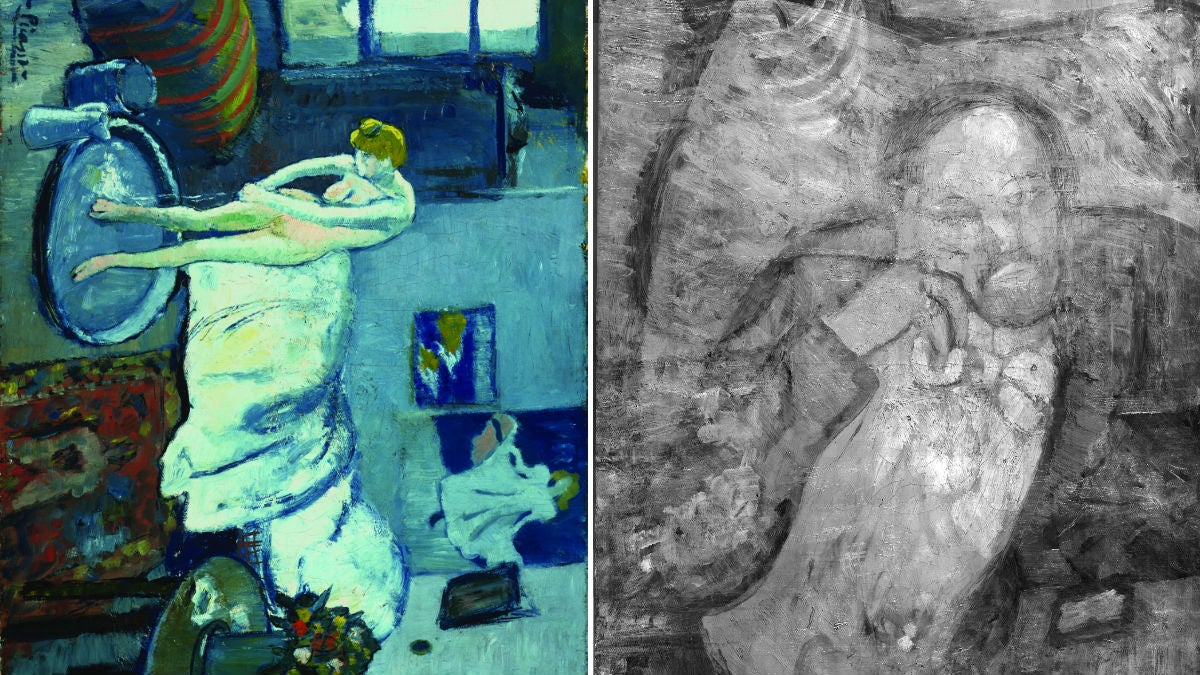International art mystery comes to Delaware
Listen
Picasso's 1901 painting "The Blue Room" as it looks now on the left and the mysterious man hidden underneath on the right. (images courtesy The Phillips Collection, © Estate of PabloPicasso / Artists Rights Society (ARS), New York)
It’s an international art mystery, stretching from Paris to Washington, D.C. to Delaware. Workers at Winterthur try to learn who was the man behind Picasso’s “The Blue Room.”
In 1901, Pablo Picasso painted “The Blue Room,” an interior scene featuring a woman who has just finished a bath. It’s an important work in its own right, representing the start of Picasso’s Blue Period. A time when, following the death of a close friend, his art turned both blue in color and blue in emotional theme.
“It is a color that’s associated with a kind of melancholy and emotional qualities that he injects into his painting,” said Susan Frank, assistant curator for The Phillips Collection in Washington, D.C.
But there’s something very intriguing about this internationally acclaimed painting, and it’s hiding just beneath the surface. “If you just look at the painting, the texture of the paint just doesn’t match the image that you see, so that’s a clue to know that there’s something underneath,” said Patricia Favero, also of The Phillips Collection, which owns the painting.
As it turns out, Picasso painted “The Blue Room” right on top of another work he painted depicting a man sitting at a café. The hidden painting was first suspected in the 1950’s, but art conservators at that time had little technology to help them discover who or what was hidden below. Fast-forward more than half a century and technology is finally able to start to piece together the mystery.
Favero has spent hundreds of hours trying to learn more about the hidden man beneath “The Blue Room”. “I wanted to see if we could either get a better image or just learn more about the painting, to see if we could get some clues to identify the sitter.”
To further the investigation of the hidden painting, Favero turned to Jennifer Mass, a senior conservation scientist at the Winterthur Museum in Delaware. Mass then connected with researchers at Cornell University with whom she had previously worked to develop confocal x-ray fluorescents. Mass explains, “Which is a microscope that allows you to do what we call depth profiling where you define a focal point for the x-ray beam, so you’re going sort of micrometer by micrometer through the paint layers and getting elemental information.”
Mass and Favero used that elemental information to identify the specific paints Picasso used in the hidden painting. Back in D.C., the team also got help from John Delaney, a senior imaging scientist at the National Gallery of Art. “It’s actually, probably the most complete study of any Blue Period paintings in terms of technically. They have a good understanding of what the palette is, what the distribution of paint is, how it relates to the final composition,” Delaney said. “They’re probably very close to knowing who maybe the sitter would be.”
So what does the man hidden beneath “The Blue Room” look like in color? It’s a difficult question with no easy answer. “The conservators and curators are working with us to pour through this data and come up with what will ultimately likely be done in a program like Photoshop to sort of fill in and reconstruct what the painting looked like originally,” Mass said.
While they could probably make a fairly educated guess about the colors of the hidden painting, that could be risky. “We certainly don’t want to suggest something that isn’t there, and then give that to the art historian and say, ‘Here, this is what it looked like,” Favero said.
The technical lessons learned from “The Blue Room” can now be applied to some other works. “There’s a lot of paintings that have been modified and changed and people want to understand, and this is just giving a whole new opportunity to look at it,” Delaney said.
And for these conservators and art historians, unraveling this mystery means the discovery of another masterpiece. “I think it’s a pretty significant discovery that we made, it was only possible with the collaboration, it took everybody involved to figure this out,” Favero said.
There are tentative plans for an exhibit that features the science behind the scenes. “We’re really bringing a new Picasso to light for our historians to study and for the public to see for the first time,” Mass said.
WHYY is your source for fact-based, in-depth journalism and information. As a nonprofit organization, we rely on financial support from readers like you. Please give today.





